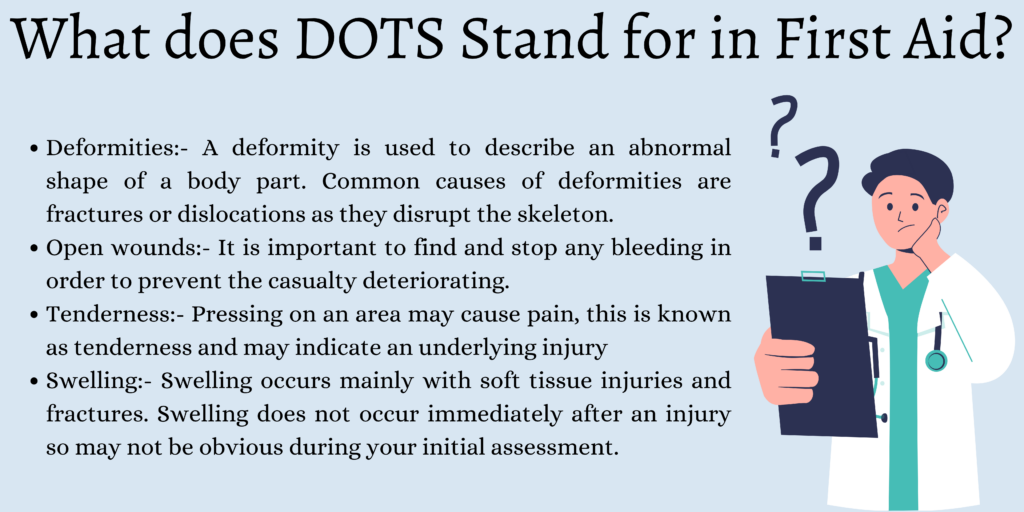What does DOTS stand for in first aid?
DOTS is an acronym used to remember what to look for when conducting a physical assessment of a casualty. Before providing emergency first aid treatment, you will need to assess the patient for possible injuries, and knowing DOTS can help you conduct a thorough check, even in a high-pressure emergency.
Assessing a patient using DOTS is particularly helpful in cases where the patient is unconscious or unresponsive and, therefore, unable to verbally explain or physically show you the location of an injury.
DOTS stands for:
- D – Deformities
- O – Open wounds
- T – Tenderness
- S – Swelling
These four signs are common indications of an injury to a body part. Once you’ve established the presence of an injury, you can take steps to provide emergency first aid if there is no trained medic present.
Let’s look at each of the four tenets of DOTS

Deformities
A deformity is used to describe an abnormal shape of a body part. Most people think of deformities as something a person is born with. Still, the word can also refer to new and temporary changes to the shape of a body part due to injuries such as a fracture or dislocations.
The best way to check for a deformity is to compare the body part to the body part on the corresponding side. So, using the wrist as an example, check to see if the patient’s other wrist looks the same or different. This can help you establish if a deformity due to injury needs to be addressed.
Open Wounds
Searching for open wounds is an important part of assessing a casualty, especially if the person is unresponsive. Finding and stopping any bleeding is important to prevent the casualty from deteriorating. Plus, open wounds can quickly lead to a serious infection, so it’s crucial to locate and clean the wound quickly and thoroughly to prevent this.
Wounds can be hidden and not immediately obvious, so you may have to go searching! When tending to an open wound, always protect yourself and the person you are treating by wearing gloves.
Read our in-depth blog post here to find full guidelines and instructions for treating open wounds in a first-aid situation.
Tenderness
Pressing on an area may cause pain. This is known as tenderness and may indicate an underlying injury. Tenderness will occur before other more visible signs become obvious (for example, bruising or swelling).
To locate tenderness, gently press on any areas with suspected injury and ask the patient to communicate their level of pain. If the patient is unresponsive or unable to communicate, you should always look at the face when assessing for tenderness. This can give you a clue as to the location and possible nature of the injury. You may see a pain response if you press over an injury, even if the patient cannot verbalize their discomfort.
Swelling
Swelling occurs mainly with soft tissue injuries like strains and sprains and hard tissue injuries like fractures. Swelling does not usually occur immediately after an injury, so it may not be obvious during your initial assessment. It can often take several hours for swelling to develop fully, so the patient may be in significantly more pain due to the body’s inflammatory response. For more information about treating strains and sprains in a first-aid situation, see our comprehensive blog post. You can also learn more about the first aid management of fractures here.
Conclusion
DOTS is a helpful, easy-to-remember acronym that stands for Deformities, Open wounds, Tenderness, and Swelling.
These features are all strong indications of injury, and knowing these signs is crucial during a first aid physical assessment.
By locating an injury using DOTS, you can take steps to provide any necessary first aid emergency treatment before the patient is able to be seen by a trained medical professional.





